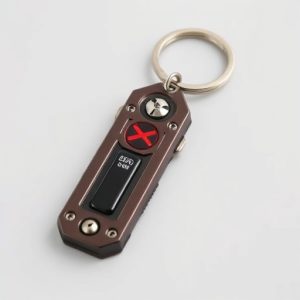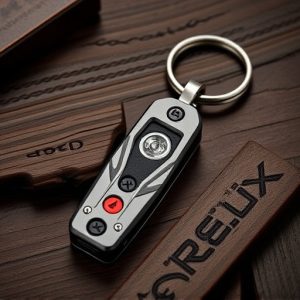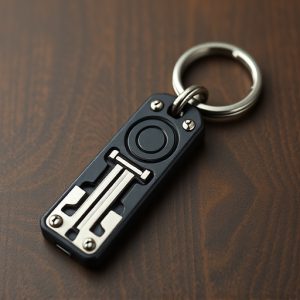Mastering Metal Defense Keychain Design: Tactics for Ultimate Grip
Designing effective tactical keychains requires integrating advanced weapon techniques with compactn…….
Designing effective tactical keychains requires integrating advanced weapon techniques with compactness and ease of use. Balancing material science – using alloys like stainless steel or titanium for durability – with ergonomic shaping ensures secure, comfortable handling under pressure. Incorporating defensive features like spikes, hooks, and serrated edges enhances self-defense capabilities in close-quarters combat or slippery situations. Thorough testing and user feedback iteration are crucial to refining the design, ensuring the tactical keychain becomes a reliable, versatile tool for everyday carry and emergency defense.
“Unleash the power of self-defense with a tactical keychain grip—a compact, powerful tool for everyday carry. This guide dives into the art of designing metal defense keychains, exploring essential tactics and techniques. From understanding fundamental design principles to selecting robust materials, you’ll master the craft. Learn how ergonomic features ensure swift access during critical moments. Discover the integration of defensive elements like spikes and hooks, enhancing your keychain’s capabilities. Finally, refine your creation through rigorous testing.”
- Understanding Tactical Keychain Design Principles
- Material Selection for Optimal Durability and Performance
- Ergonomics: Creating a Comfortable Grip for Quick Access
- Incorporating Defensive Features: Spikes, Hooks, and More
- Testing and Refining Your Metal Defense Keychain Grip Design
Understanding Tactical Keychain Design Principles
When it comes to tactical keychain grip design, understanding the principles behind effective weapon techniques is paramount. A tactical keychain isn’t just about convenience; it’s a tool designed for survival and self-defense scenarios. The key lies in balancing functionality with compactness. Incorporating features like a textured grip ensures a secure, slip-free hold even under extreme pressure. This is crucial when deploying the keychain as a defense mechanism, especially in high-stress situations.
Tactical keychain weapon techniques focus on versatility and ease of use. A well-designed grip allows for one-handed operation, enabling users to access their defense tool quickly and efficiently. Additionally, the design should consider materials that offer durability and corrosion resistance, ensuring the keychain stands the test of time and various environmental conditions. Effective tactical keychain designs are a blend of art and science, leveraging innovative techniques to create compact yet powerful self-defense solutions.
Material Selection for Optimal Durability and Performance
When designing a tactical keychain grip, material selection is paramount for achieving optimal durability and performance—key factors in crafting an effective self-defense tool. Opt for high-quality metal alloys like stainless steel or titanium, renowned for their exceptional strength-to-weight ratios and corrosion resistance. These materials ensure your keychain can withstand rigorous use, from daily carry to emergency situations.
Consider the specific tactical applications when choosing. For instance, a harder metal like carbon fiber or ceramic may offer superior edge retention if your keychain includes a small blade component. Conversely, softer metals provide better grip and are easier to work with during crafting. The right material choice marries durability with functionality, making your tactical keychain weapon techniques both reliable and versatile.
Ergonomics: Creating a Comfortable Grip for Quick Access
When designing a tactical keychain grip, ergonomics play a vital role in ensuring comfortable and efficient use. The goal is to create a design that fits naturally within the hand, allowing for quick access to your keys, especially in high-stress situations. Consider shaping the keychain to accommodate the natural curves of the palm and fingers, enabling a secure, non-slip grip. This ergonomic approach ensures users can easily manipulate the keychain, even with gloved hands or in challenging environments, making it a practical tool for those who rely on tactical keychain weapon techniques.
Focusing on comfort also enhances usability. A well-designed grip minimizes hand fatigue, enabling users to perform tasks without strain, especially when attached to a keyring. This is particularly important for individuals who carry their keys on a daily basis or for those in professions requiring frequent key manipulation, such as first responders or security personnel. By prioritizing ergonomics, the tactical keychain becomes not just a functional tool but also a reliable companion for everyday tasks and emergency situations alike.
Incorporating Defensive Features: Spikes, Hooks, and More
When designing a tactical keychain grip, incorporating defensive features is paramount. Spikes, for instance, can provide additional leverage and protection during self-defense scenarios, allowing users to gain control more effectively. These sharp projections not only deter potential attackers but also give the user a strategic advantage in close-quarters combat. Hooks, another versatile option, enable quick grab points for better manipulation of the keychain, enhancing its utility as a makeshift weapon.
Beyond spikes and hooks, other tactical elements like serrated edges or knobby textures can significantly improve grip strength and stability. These features are particularly useful when dealing with slippery surfaces or attempting to defend against multiple attackers. By integrating such defensive techniques into your keychain design, you’re not just creating a functional accessory; you’re arming users with a versatile tool capable of defending against tactical situations using nothing but their everyday carry.
Testing and Refining Your Metal Defense Keychain Grip Design
When refining your metal defense keychain grip design, testing is paramount. Crafting a tactical keychain weapon requires understanding how users will interact with it in various scenarios. Conduct thorough trials to assess comfort during prolonged use and ensure the grip doesn’t slip under pressure. Gather feedback from potential users, especially those familiar with similar tools, to identify any usability issues or points of improvement. This iterative process is key to creating a design that not only looks intimidating but also performs effectively.
Refining your keychain grip involves balancing aesthetics and functionality. Experiment with different metal alloys to find the perfect combination of strength, weight, and corrosion resistance. Consider ergonomic principles to prevent strain during intense use, ensuring the grip fits comfortably in the hand. Incorporate subtle texturing or patterns for added traction without compromising the smooth operation of the keychain’s tactical functions. By combining these tactical keychain weapon techniques, you’ll create a well-rounded, reliable defense tool that stands up to rigorous testing.
When crafting a metal defense keychain grip, combining tactical design principles with thoughtful material selection, ergonomic comfort, and strategic defensive features is key. By adhering to these essential tips, you can create a robust and versatile tool that seamlessly integrates functionality and protection. Incorporating the right spikes, hooks, or other defenses adds a layer of security, making your keychain a formidable tactical weapon in various situations. Remember, the best designs are those tested and refined through rigorous trials, ensuring optimal performance under pressure. With these tips in mind, you’re well on your way to crafting a game-changing tactical keychain grip that enhances personal safety and convenience.


